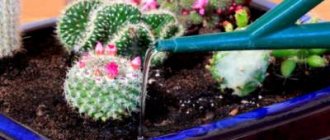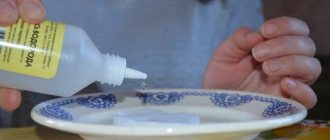Why should the water be warm?
If you use water with a temperature below 15 degrees for irrigation, this can lead to the following negative consequences:
- Slowing down all biological processes of plants.
- Many substances do not dissolve well in cold liquid. For this reason, watering will prevent the plants from receiving the necessary benefits.
- When watering with cold liquid, young shoots of the root system are severely damaged.
- Cold watering reduces the immunity of plants, making it more difficult for them to resist diseases and pests. The ability to recover is also impaired.
To avoid unpleasant consequences and ensure normal growth and development of plants, water them only with warm water. A temperature of 25-30 degrees or slightly higher is considered acceptable.
How long and what to do then?
For small plants - about 10-15 seconds, adult plants up to 30 seconds, large plants (if you can bring them into the bath) longer.
We scald everything: the pot, the soil, the stem, the leaves on both sides. This is the most effective.
It is best to collect a whole group of plants
, rinse them all well, and close the bath with a curtain, creating
the most effective steam bath
. This is an excellent way to reanimate plants.
By the way
: A couple drops of dish soap will not only clean the foliage even better, but will also keep any insects at bay...
away from your plants
. Prepare a container for several liters of hot water, add a couple of drops of the product, shake, wipe and rinse the leaves at the very end of the procedure. No need to rinse off.
After a shower, leave the plant in the bathroom for at least three hours, removing the trays to drain excess water. To prevent the plant from catching a cold, it is better to close the door to the bathtub. After a few hours, open the door, let the plant stand in the bath a little longer, and then you can take it out to its usual place. It is not advisable to place it on a cold windowsill (only when the plant and pot have completely cooled down). Protect from drafts during the first days.
After this procedure, you may not need to water the plant for even two weeks, but it all depends on the size of the pot and the dryness of the air.
After the soil has completely dried, the next time you water it, you can feed the plant with complex fertilizer so that the soil is not depleted.
If the plant is affected by pests
, first wash the leaves (covering the soil so as not to introduce pests into it), and only then take a hot shower. After the procedure, it is advisable to wash the leaves and trunk with green soap for plants.
When is it possible to water with cold water?
With the onset of the cold season, the period of active growth of most plants ends, so watering with warm water becomes inappropriate. During this period, you should adhere to two rules:
- plants that are in a state of complete dormancy (this applies, for example, to deciduous fruit trees) are watered with cooler liquid (12-15 degrees) in winter. Otherwise, the growing season may begin prematurely, which should not happen in autumn or winter;
- plants that have stopped growing in the autumn-winter period must be watered with water colder than the air temperature in the room (8-12 degrees).
But not all plants go dormant during the cold season. If the growth period has not stopped or, for example, flowering has begun, only warm liquid should be used for watering. Excessive cold during this period can lead to disease of the root system, as well as the falling of flowers, leaves and ovaries.
Now you know what kind of water you need to use for irrigation. But do not forget that there are exceptions to any rule. Therefore, if you doubt whether it will be useful to water a particular plant with warm boiled water, seek advice from an experienced gardener.
Contraindications
For flowering plants, we do not use a hot shower, but spray with hot water (without touching the flowers). But it is not so effective, because the steam room effect is not achieved. It is better to let the plant bloom, and only then arrange hot procedures (and it is also advisable to do it before flowering).
Do not apply after transplantation, only when the plant has taken root.
Do not use on plants with velvety, pubescent leaves (Saintpaulias, Gloxinias, Begonias).
Use caution on plants with young leaves to avoid causing burns. For tender leaves, make the water less hot.
In autumn and winter, you should not put cacti and succulents in the shower. In general, these plants do not need to be watered in winter.
Frequently asked questions: About watering
Home / Frequently asked questions| Proper watering |
- What kind of water should I use? How to soften water? By available means? Can it be boiled? Who uses filters, is there any benefit?
- Is it really possible to water flowers with mineral water? it contains minerals needed by flowers, but in smaller quantities than in mineral fertilizers, in addition, it contains oxygen.
- How to acidify water?
- Do plants need iron?
- Is it possible or not to water plants with boiled water?
1. What kind of water should I use? How to soften water? By available means? Can it be boiled? Who uses filters, is there any benefit?
Answer:
You can filter water with a filter containing ion exchange resins or osmotic membranes, the result is excellent. But the process is long, and when you need to filter 15-20 liters in order to water all the flowers, it is simply painful. Plus, you regularly need to buy new filter cassettes, which, with intensive use, become clogged within a month or a month and a half.
Boiling water is also effective and also a chore. In addition, when boiling, air is removed from the water, which is not good for plants (the amount of dissolved oxygen is so small that it has no effect on the plant, unless, of course, it is flooded). It’s good to water with snow water, although, of course, it’s also a chore: the volume of snow is large, but you don’t get enough water. In addition, in the city a lot of smoke and dirt settles on the snow; it is better to collect it in the forest away from the highways, which in itself is not always feasible.
In stores you can find a “decalcifier,” that is, “a special product for neutralizing water hardness.” As they write in the annotation, “binds calcium and magnesium salts (causing water hardness), softening water for watering plants.” 500 ml - 85 rub. Most likely this is a solution of sodium salt EDTA, in any case, in the household you can use EDTA (Trilon B) as an anti-scale agent, but calcium dissolves and becomes a complex, but does not disappear.
About watering with cold “hot water”. Softeners and inhibitors are indeed often added to hot water from thermal power plants and boiler houses. However, this water circulates in a closed cycle and does not enter the water supply system. Through a heat exchanger, it heats ordinary cold tap water, which flows from the tap hot. Those. Hot tap water has the same chemical composition as cold water. But there are two differences.
First: hot tap water is most often softer and contains fewer dissolved gases, since the solubility of hardness salts and gases decreases with increasing temperature.
Second: the solubility of everything else increases with increasing temperature. So if the hot water supply system is very old or, on the contrary, completely new, then the hot water may be more “rusty” because it will dissolve iron salts that are present in old and completely new pipes. In addition, hot water can sometimes have an unpleasant taste, which it gets from plastic and rubber parts of the plumbing system (this almost never happens in residential buildings). This taste does not affect the chemical composition of the water in any way.
Conclusion: in the vast majority of cases, if you live in a normal residential building and your hot water is not rusty, it is better to settle it for irrigation. The taste, if there is one, can be ignored.
Freezing water in the freezer can only give a positive result in softening the water if it is frozen correctly. If you simply freeze water, then all the salts are included in the ice, and when it thaws, they return to the water. To obtain melt water, you must first monitor the process by freezing the water. Water does not freeze immediately; a certain amount of water remains, which then also freezes, but it is this water that does not immediately freeze that is a saturated saline solution, which has a lower freezing point. If you have time to drain this unfrozen solution, then the melted ice will produce melted, soft water. Otherwise, freezing makes no sense. Another thing is that there are different cities and the ecology too. If someone’s municipal water supply system is doing a bad job, then there’s no point in arguing, it will be pointless. And hot water is not chlorinated. This is pointless, because... it undergoes intensive boiling in boiler rooms, on the walls of which, by the way, harmful magnesium and calcium salts remain.
The only reliable means of softening cold water is the addition of oxalic and some other acids to control acidity. But you still need to protect it from chlorine.
2. Can you really water flowers with mineral water? it contains the minerals needed by flowers, but in smaller quantities than in mineral fertilizers, in addition there is oxygen...
Answer:
Firstly, where does the oxygen come from? There is carbon dioxide there, but there is hardly more oxygen than in ordinary water.
And most importantly, the composition of mineral (not drinking, but medicinal mineral) waters is very different. There are ferruginous waters, and there are sulfurous ones. And plants need a certain balance of microelements. Precisely micro, since there is not enough nitrogen and phosphorus in the mineral water, this is not slurry...
Secondly: why? There are many fertilizers for indoor plants on sale. There are microelement complexes, for example, “Cocktail”. Why reinvent the wheel? There will be no savings from this either: by diluting liquid fertilizer, we will get much more solution than you can buy mineral water with this money. What's the point?
This is entertainment for the lazy. Poor tap water is indeed a problem, but then you need to water it not with mineral water, but with drinking water. For example, the one sold in five-liter plastic bottles. Or the one in 20-liter bottles for office drinkers (this is really soft water, since the method of ion exchange resins or osmosis is used for purification).
3. How to acidify water?
Answer:
You can acidify with citric acid, i.e. it gives an effect. Here is a person with 15 years (!) of experience in growing bonsai directly advises: “3-4g per 10 liters, or, if funds allow, ascorbic acid.” https://www.bonsai.ru/agro/nachalo.html Whether acidification is NEEDED depends on the species characteristics of the plant; some need it, others don't. For example, many orchids need this.
4. Do plants need iron?
Answer:
Everyone needs iron, like other microelements, copper, cobalt, molybdenum, zinc. Moreover, iron can exist in different forms, divalent and trivalent. Plants for the most part need divalent. You can see more details at https://www.msaqua.com/pmdd/iron.htm
5. Is it possible or not to water plants with boiled water?
Answer:
We need to look at what will cause more harm to this particular plant growing in this particular pot in this particular soil - from watering with unboiled water (hard, chlorinated, etc.), or from watering with boiled water (no air, hardness decreases, but maybe not completely, etc.). There are plants that are very sensitive to calcium salts. On the contrary, there are plants that love calcium. There are other plants. There are other methods of softening water. In general, how is hard water harmful? Because the soil quickly becomes salty. The same result can be “achieved” by too much inept and frequent feeding. Each gardener has his own opinion on this matter, due to the fact that he has more access. You need to watch how the plant reacts and act accordingly.
How to determine that such watering is not suitable?
Signs by which you can determine that such watering is not suitable for a particular plant:
- the tops of the shoots die off;
- buds fall;
- root rot develops;
- the plant withers.
If water for irrigation is not suitable for flowers, even fertilizers are unlikely to neutralize their deteriorating condition.
Advantages and disadvantages
A significant advantage is that, unlike raw water, boiled water contains significantly fewer harmful substances that can worsen the condition of indoor flowers.
Boiled water has a serious drawback - it contains minimal oxygen and nutrients.
But this minus is compensated for in several ways:
- The shortage of necessary elements can be eliminated by applying fertilizers.
- Leave the water to stand for 24 hours, after which it will become more enriched with oxygen.
- Periodically loosen the soil, which will improve root oxygen saturation.
LiveInternetLiveInternet
Wednesday, March 26, 2014 07:21 + to quote book Yes, yes, you heard right - it’s hot! I have heard advice many times about how useful it is to bathe your plants in boiling water. And a hot shower for indoor plants is an excellent awakening from winter hibernation. But not only. A “hot shower” for your plants with a water temperature of 40-50°C is a very effective procedure for caring for indoor plants. Often the result of even one such procedure can be seen with the naked eye within a week. A hot shower is a healing jolt for indoor plants; it has a tonic and revitalizing effect on them, invigorates and strengthens them.
How do houseplants benefit from a hot shower? new leaves appear quickly or the plant begins to bloom; the falling and yellowing of leaves stops; dirt and dust are washed away from all veins and pores inaccessible to rags and sponges, the plant “breathes easier”; if before a shower you treat the leaves affected by mites with Fairy foam, this will rid the plant of parasites; spilling the soil during a shower washes out all unnecessary and necessary salts and minerals, so you don’t have to worry about overfeeding the plant; the plants improve their appearance and leaf turgor. But, I note, you need to treat hot showers with caution; not all plants will be happy with it. As with many treatment methods, there are contraindications: flowering plants should not take a hot shower; it is better to simply spray the leaves with hot water from a spray bottle (bypassing the flowers); Transplanted plants should also not be given a hot shower until they take root; they can only be sprayed with warm water; Plants with pubescent leaves, such as Saintpaulias, gloxinias, and begonias, cannot be moistened with water at all; they may die from excess moisture.
Hot shower technology and notes on it. A hot shower very rarely has a negative effect on plants; I personally have not had such cases yet. To keep everyone happy, it is enough to follow a few simple rules. The technology for performing a hot shower for indoor plants is something like this: About an hour before the procedure, the plant needs to be watered. A hot, dry shower can “cook” the plant. The temperature of the shower water is approximately 40-50°C. The water should be warm, maybe a little hot, but the hand should tolerate it freely. If you do not plan to spill soil along with the leaf shower, you can cover it with cling film or a bag. Turn on the shower, spray finer and water the plant from different angles, washing all the pores and veins that are inaccessible to rags and sponges. Depending on the size of the plant, the duration of the procedure ranges from 30 seconds to 1 minute. After the procedure, it is important not to let the plant catch a cold: if the apartment is cool, it is better to leave the freshly washed plants in the bathroom for several hours to dry a little and come to their senses. After watering the soil during a shower, the plants do not require watering for a week or two, depending on the size of the plant and pot. A few more notes. On the phalaenopsis orchid, after water treatments, I shake out the water from the axils of the leaves so that they do not rot. But before the shower, I cover the soil with cling film - after all, the plant comes from arid places, so you shouldn’t flood it. Our biggest fans of hot showers are phalaenopsis, aglaonema, spathiphyllum and chlorophytum. In phalaenopsis, the turgor (density) of the leaves is improving, after a shower, aglaonema stopped shedding its lower leaves and produced several new ones, and in spathiphyllum and chlorophytum, the edges of the leaves stopped turning yellow and began to form several new leaves at once.
Hot shower for phalaenopsis orchids Some plants like hot showers, while others are indifferent to it. Here are the plants that can be prescribed a hot shower: - Affelandra, Alocasia, Strelitzia, Anthurium, Adenium, Scindapsus, Croton, Aglaonema, Coleus, Cordyline, Dracaena, Clivia, Zameoculcas, Gardenia, Phalaenopsis Orchid, Fuchsia, Maranta, Dendrobium Orchid, Monstera, Calathea, Eucharis, Chlorophytum, Nolina, Dieffenbachia, Citrus. Here are a few plants that welcome this procedure with a bang: Spathiphyllum Schefflera Phalaenopsis Gardenia Aglaonema Maranta Syngonium Rose Violet Guzmania The listed plants, which even felt normal without any shower, respond to hot dousing very gratefully, literally within a week producing new leaves and shoots and rapidly starting to grow.
Calamondin, ficus and phalaenopsis after a shower. I invite everyone who has something to add on the topic of plant care to share their comments in the comments. /florainhome.ru
| Categories: | alluring world of flowers |
Tags:
about caring for plants, hot shower
Cited 577 times Liked by: 206 users
Like share
0
Like
- 206
I liked the post - 577
Quoted - 7
Saved
- 577
Add to quote book - 7
Save to links
Liked206
0
How is this useful?
- The stems and foliage are cleaned of various dirt. When the pores on the leaves are clogged, home crops cannot “breathe” properly. Accordingly, the plant cannot develop to its full potential.
- The foliage is saturated with moisture.
- The hot stream of water stimulates the growth of fresh shoots and foliage.
- High temperatures are a problem for most harmful organisms that cause diseases in houseplants. The water procedure is an excellent prevention.
- The roots become stronger and begin to grow faster, which will have a beneficial effect on the plants as a whole.
Usually, only the green top of the plant is watered, and the soil layer is not touched. But you can also spill the containers completely.
Who doesn't like to swim?
Indoor plantings with voluminous and lush leaves love water treatments. Watering also has a beneficial effect on other green pets. However, there are always exceptions to the rules.
These include:
Violets. The illustration for the article is used under the standard license ©ofazende.com
- indoor plants with pubescent foliage (for example, violets). It is not prohibited to bathe them, but this should be done infrequently and then dried thoroughly. Because accumulated water droplets can cause damage to leaves;
- succulents with fleshy foliage (such as dollar trees). They stock up on moisture, storing it in the foliage in order to survive for a long time without watering. Saturation with moisture will give a signal to the plant that there is too much water, and the foliage will begin to fall off.
Rock garden.
The illustration for the article is used under a standard license ©ofazende.com Such crops are bathed only in case of severe contamination.
Alcohol tinctures
If the plant is small and you have the time and patience, use a damp cotton swab with diluted alcohol (for smooth, hairless leaves only!) to wipe the plant to clean the leaves. This will also help remove spider mites, which tend to live on the underside of leaves rather than on top. This is an option if you don't want or can't have a shower.
- Soil, drainage, plant fertilizers
Instead of pure alcohol, you can buy alcohol tincture of eucalyptus, calendula, etc. at the pharmacy, this is also an additional
protection from pests.
And remember: houseplants can help increase your vitality and give you a feeling of extra energy. Plants can have a positive impact on your mental health, help improve family relationships, and give you a sense of a higher quality of life. Take care of them, they are worth it!
Plus, they never go out of style and can live with you for a lifetime!
How to properly water flowers from the shower with hot water
Bathing beautiful decorative foliage. Illustrations for the article were taken from the Internet
- One day before, it is necessary to water the crop using the usual method. This is necessary so that the flower does not borrow “extra” water.
- It is recommended to adjust the shower stream - the water temperature is forty to sixty degrees Celsius.
- It is necessary to cover the land - water should not fall on it, or hold the container tilted and water from the side.
- The time period for the procedure is thirty seconds!
- Let all the water drain and the crops dry in a warm place without drafts.
Repeat the procedure at least monthly. Cultures will express their gratitude to you in the form of abundant growth.
How to choose water
You already understand that you only need to water with water, but what kind of water? There are several criteria for selecting the optimal water for plants:
- temperature;
- chemical composition;
- acidity level.
Let's take a closer look at each of these points.
The first criterion is water temperature
For irrigation, you need to use water at room temperature - approximately 18–23 °C. Cold water, just like warm water, has a bad effect on the plant body. The fact is that the flower may experience temperature stress. At the same time, a large amount of hormones is produced, plant growth slows down, and in some cases the flower dries out and dies.
Sometimes it is allowed to use warm water for watering indoor flowers. For example, for orchids during the flowering period.
The second criterion is the chemical composition
A very important criterion is the presence of organic and inorganic impurities in water. The main enemies of plants are chlorine and heavy metals. They are able to settle on the roots and destroy them, which leads to disruption of the mineral nutrition of the flower. Therefore, you need to know where exactly to get water so that it contains a minimum amount of harmful substances.
Is it allowed?
Watering flowers with boiled water is possible and even necessary.
Many plants have a very negative attitude towards hard H2O, which is drawn from the tap . If you water them regularly, this will lead to gradual salinization of the soil cover.
The roots have a thin membrane that absorbs nutrients after watering. Calcium does not dissolve well in hard water, so if you water plants with it, the pores of the membrane will begin to clog, disrupting water exchange. Their condition will worsen, the flowers may even die.
To protect plants, it is recommended to soften H2O . One method is boiling. After boiling, magnesium and calcium salts settle at the bottom of the pan.
In addition, disinfection occurs - many polluting substances harmful to plants disappear.











